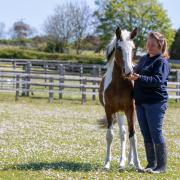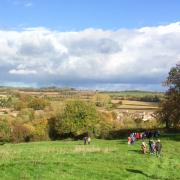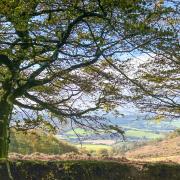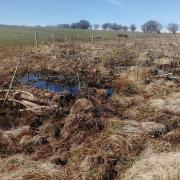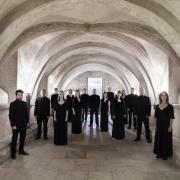MARK G WHITCHURCH takes a Jaguar F-type on a great drive from Portishead Marina to Glastonbury Abbey; a journey that transcends the spectrum of Somerset’s buildings, from beauty to spiritual enlightenment


The chic, modern development of Portishead Marina has to be one of the most dramatic transformations of landscape that Somerset has experienced in the last few decades.
Not that long ago this Miami-esque marina with its posh yachts, opulent cruisers and penthouse apartments was the site of a power station fuelled by coal that was mined in Somerset and transported by the county’s steam locomotives, ultimately providing electricity to the communities of Bristol.
Leave the prestige of Portishead’s waterfront, traveling towards Clevedon on the B3124 before turning left towards Clapton-in-Gordano to join the B3128 in the direction of Bristol.
Continue past Tyntesfield to meet the B3129 travelling down Belmont Hill to the B3130 where it’s left to cruise through Barrow Gurney to the A38. A short blast south in the direction of Bristol Airport to re-join the B3130 passing through Winford and the pretty village of Chew Magna.
Look for the signs for the Chew Valley Lake Visitors Centre, where a short stroll and maybe an ice cream make for a pleasant pause in the journey.
Back on the road head for Bishop Sutton and the A368. Turning right, travel through Sutton Wick for more spectacular views of the Chew Valley Lake. In West Harptree turn left onto the B3114 and continue through the hamlet of Litton and then the village of Chewton Mendip to meet with the A39.
Skirt the Mendip foothills on the A39, through Green Ore and drop down into the city of Wells, not only famous for its majestic cathedral and bustling Saturday market, but also for having the oldest residential street in Europe, complete with its original buildings. Vicars’ Close, next to the Cathedral was built in the 1360s as an extension of the cathedral by Bishop Ralph of Shrewsbury.
Leave Wells on the A39 past the fascinating reclamation yard with a rocket launcher in its entrance and onward to our final destination of Glastonbury.
The bohemian atmosphere of this cult town feels poles apart to that of the glamour of Portishead Marina! A friendly town with an active high street full of interesting shops and boutiques.
Whilst the lure of the Tor is obvious when in Glastonbury, we opted for an appropriately alternative destination. Billed as once being the ‘grandest and richest Abbey in England’, the ruins of Glastonbury Abbey are today set in tranquil parkland that is punctuated by some of Somerset’s most evocative medieval history.
A quaint museum and gallery tell of the Abbey’s past association with King Arthur. Step outside to admire the remains of the Abbey which erupt from the grassy fields like mythical creations, providing tantalising glimpses of how imposing the Abbey must have been in the 14th century when it was completed. Destroyed in the 16th century during the reign of Henry VIII in what is known as the Dissolution of the Monasteries, Glastonbury Abbey today makes for a truly magical place to end a Great Drive.
Jaguar F-Type:
The much anticipated F-Type perfectly articulates the forward direction of the Jaguar marque: lustful design yet with a hint of nostalgia. Echoes of the E-Type’s evocative form are in evidence from every angle, but the overall design is sharp and undoubtedly from the modern school of sports car design.
If, as for me, the F-Type’s taut lines get your heart beating that little bit faster, then you are in for a real treat. I would personally go as far as to say “this is my car of the year” and I am lucky enough to have experienced some impressive driver-focused machinery.
Unlock the door and the flush fitting door handle flicks out, like that of a 1950’s Mercedes SL. The drama continues within the cocoon of the driver-orientated cabin where a pulsating, orange anodised starter button beckons your finger to press it, resulting in an orchestral eruption of mechanical noise. The racing style flat bottom steering wheel, together with body hugging leather line seat, perfectly connect man with machine.
Impeccable interior build quality, top line materials and inviting design convincingly postures the F-Type to its German competition, with the model neatly fitting in between the Porsche Boxster and the legendary 911 in the sports car market. Tested in V6 supercharged format, Jaguar insists this will be the most popular model. With a zero to sixty time of 4.9 seconds and an eye watering top speed of 171mph, I quickly found myself agreeing!
The F-Type’s driving experience is wholly engaging and totally captivating; I just didn’t want to get out! What impressed me most was the F-Type’s ability to so compellingly engage the driver with some truly exhilarating driving sensations, but then at the flick of a few buttons could provide a relaxing motoring experience to rival a luxury Jaguar saloon.
In cruising mode, the exhaust is quiet and the gearbox silky smooth, seamlessly changing between the gears. Alternatively find the open road, lower the roof (even whilst on the move), unleash the full bark from the exhaust, bury the throttle and use the paddle shifts to change gears with lightning speed to experience one of the most driver-focused machines on offer today.
This transformation is aided by the F-Type’s high use of aluminium in its construction as well as a class leading suspension set up that provides an appropriately firm but never jarring ride, even over the most wrinkled of British roads.
At £70,000 including a few options, the F-Type is not only cheaper than a Porsche 911, it’s British and arguably the better sports car. The Jaguar F-Type is indeed that good!





